Innovation and Entrepreneurship in the Dija Startup Business Plan
VerifiedAdded on 2022/12/02
|12
|3557
|213
Report
AI Summary
This report provides a comprehensive analysis of the Dija startup, an online grocery delivery service operating in London. It explores the company's innovative approach, focusing on its business model, which emphasizes rapid delivery within 10 minutes, and its entrepreneurial strategies. The report examines Dija's industry profile, highlighting the growth of online grocery sales and the impact of the COVID-19 pandemic. It details the business cycle, from seed funding to potential expansion, and identifies Dija's point of difference in the competitive market. The report also addresses the challenges the startup faces, including competition and operational risks. Furthermore, it outlines the prospective customers, a brief marketing plan, and a competitor analysis, providing insights into Dija's market positioning and strategies. The report also touches on sources of funding and intellectual property considerations, offering a complete overview of Dija's operations and future prospects.
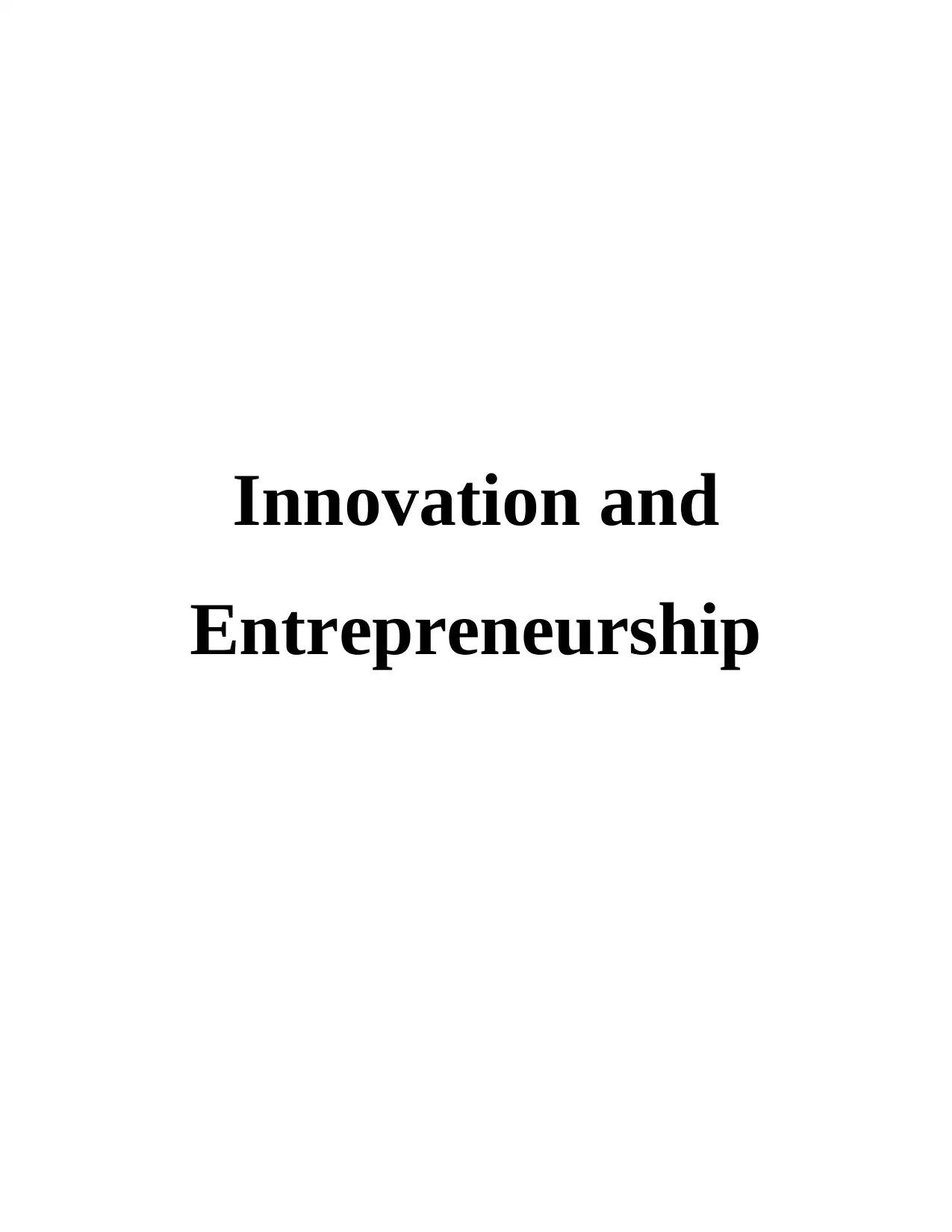
Innovation and
Entrepreneurship
Entrepreneurship
Paraphrase This Document
Need a fresh take? Get an instant paraphrase of this document with our AI Paraphraser
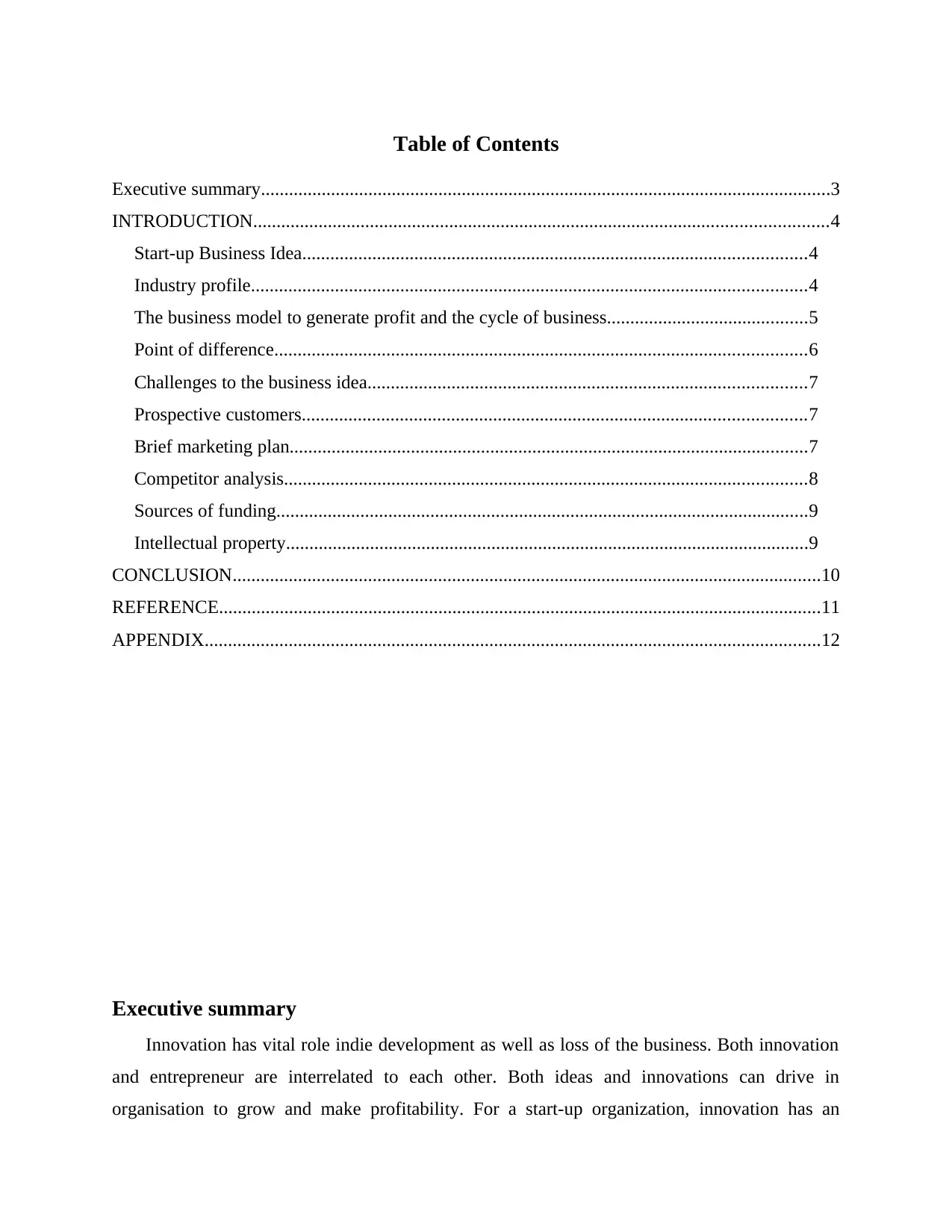
Table of Contents
Executive summary..........................................................................................................................3
INTRODUCTION...........................................................................................................................4
Start-up Business Idea............................................................................................................4
Industry profile.......................................................................................................................4
The business model to generate profit and the cycle of business...........................................5
Point of difference..................................................................................................................6
Challenges to the business idea..............................................................................................7
Prospective customers............................................................................................................7
Brief marketing plan...............................................................................................................7
Competitor analysis................................................................................................................8
Sources of funding..................................................................................................................9
Intellectual property................................................................................................................9
CONCLUSION..............................................................................................................................10
REFERENCE.................................................................................................................................11
APPENDIX....................................................................................................................................12
Executive summary
Innovation has vital role indie development as well as loss of the business. Both innovation
and entrepreneur are interrelated to each other. Both ideas and innovations can drive in
organisation to grow and make profitability. For a start-up organization, innovation has an
Executive summary..........................................................................................................................3
INTRODUCTION...........................................................................................................................4
Start-up Business Idea............................................................................................................4
Industry profile.......................................................................................................................4
The business model to generate profit and the cycle of business...........................................5
Point of difference..................................................................................................................6
Challenges to the business idea..............................................................................................7
Prospective customers............................................................................................................7
Brief marketing plan...............................................................................................................7
Competitor analysis................................................................................................................8
Sources of funding..................................................................................................................9
Intellectual property................................................................................................................9
CONCLUSION..............................................................................................................................10
REFERENCE.................................................................................................................................11
APPENDIX....................................................................................................................................12
Executive summary
Innovation has vital role indie development as well as loss of the business. Both innovation
and entrepreneur are interrelated to each other. Both ideas and innovations can drive in
organisation to grow and make profitability. For a start-up organization, innovation has an
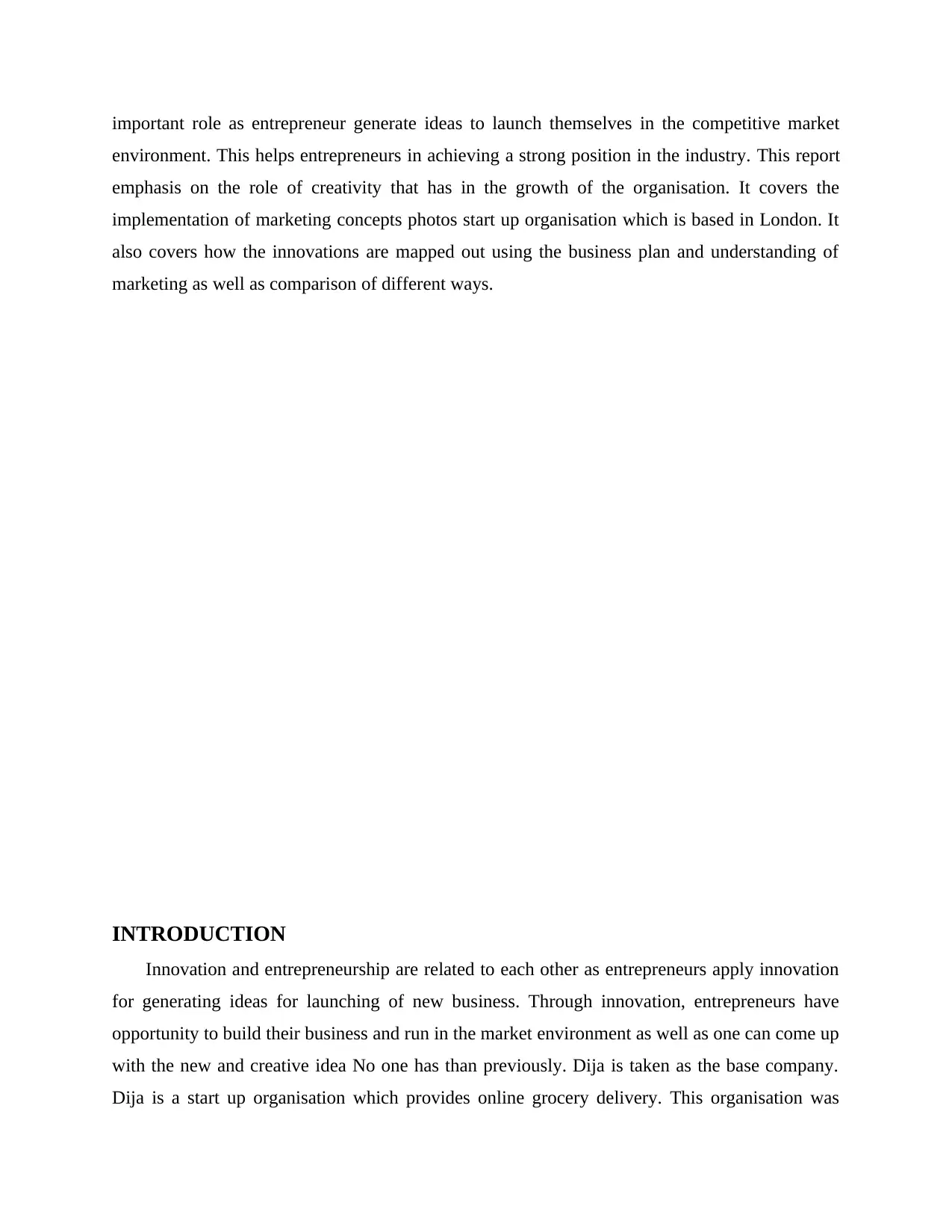
important role as entrepreneur generate ideas to launch themselves in the competitive market
environment. This helps entrepreneurs in achieving a strong position in the industry. This report
emphasis on the role of creativity that has in the growth of the organisation. It covers the
implementation of marketing concepts photos start up organisation which is based in London. It
also covers how the innovations are mapped out using the business plan and understanding of
marketing as well as comparison of different ways.
INTRODUCTION
Innovation and entrepreneurship are related to each other as entrepreneurs apply innovation
for generating ideas for launching of new business. Through innovation, entrepreneurs have
opportunity to build their business and run in the market environment as well as one can come up
with the new and creative idea No one has than previously. Dija is taken as the base company.
Dija is a start up organisation which provides online grocery delivery. This organisation was
environment. This helps entrepreneurs in achieving a strong position in the industry. This report
emphasis on the role of creativity that has in the growth of the organisation. It covers the
implementation of marketing concepts photos start up organisation which is based in London. It
also covers how the innovations are mapped out using the business plan and understanding of
marketing as well as comparison of different ways.
INTRODUCTION
Innovation and entrepreneurship are related to each other as entrepreneurs apply innovation
for generating ideas for launching of new business. Through innovation, entrepreneurs have
opportunity to build their business and run in the market environment as well as one can come up
with the new and creative idea No one has than previously. Dija is taken as the base company.
Dija is a start up organisation which provides online grocery delivery. This organisation was
⊘ This is a preview!⊘
Do you want full access?
Subscribe today to unlock all pages.

Trusted by 1+ million students worldwide
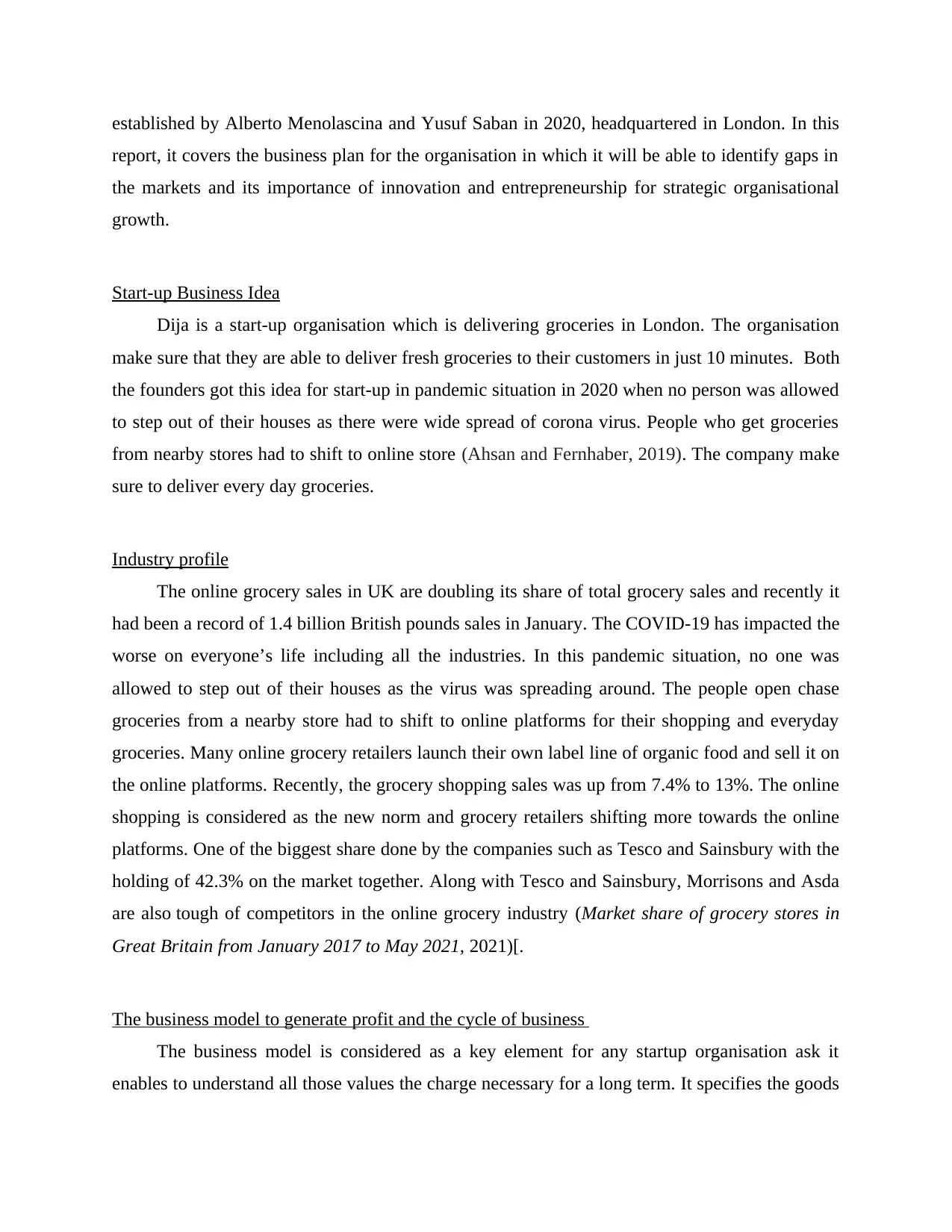
established by Alberto Menolascina and Yusuf Saban in 2020, headquartered in London. In this
report, it covers the business plan for the organisation in which it will be able to identify gaps in
the markets and its importance of innovation and entrepreneurship for strategic organisational
growth.
Start-up Business Idea
Dija is a start-up organisation which is delivering groceries in London. The organisation
make sure that they are able to deliver fresh groceries to their customers in just 10 minutes. Both
the founders got this idea for start-up in pandemic situation in 2020 when no person was allowed
to step out of their houses as there were wide spread of corona virus. People who get groceries
from nearby stores had to shift to online store (Ahsan and Fernhaber, 2019). The company make
sure to deliver every day groceries.
Industry profile
The online grocery sales in UK are doubling its share of total grocery sales and recently it
had been a record of 1.4 billion British pounds sales in January. The COVID-19 has impacted the
worse on everyone’s life including all the industries. In this pandemic situation, no one was
allowed to step out of their houses as the virus was spreading around. The people open chase
groceries from a nearby store had to shift to online platforms for their shopping and everyday
groceries. Many online grocery retailers launch their own label line of organic food and sell it on
the online platforms. Recently, the grocery shopping sales was up from 7.4% to 13%. The online
shopping is considered as the new norm and grocery retailers shifting more towards the online
platforms. One of the biggest share done by the companies such as Tesco and Sainsbury with the
holding of 42.3% on the market together. Along with Tesco and Sainsbury, Morrisons and Asda
are also tough of competitors in the online grocery industry (Market share of grocery stores in
Great Britain from January 2017 to May 2021, 2021)[.
The business model to generate profit and the cycle of business
The business model is considered as a key element for any startup organisation ask it
enables to understand all those values the charge necessary for a long term. It specifies the goods
report, it covers the business plan for the organisation in which it will be able to identify gaps in
the markets and its importance of innovation and entrepreneurship for strategic organisational
growth.
Start-up Business Idea
Dija is a start-up organisation which is delivering groceries in London. The organisation
make sure that they are able to deliver fresh groceries to their customers in just 10 minutes. Both
the founders got this idea for start-up in pandemic situation in 2020 when no person was allowed
to step out of their houses as there were wide spread of corona virus. People who get groceries
from nearby stores had to shift to online store (Ahsan and Fernhaber, 2019). The company make
sure to deliver every day groceries.
Industry profile
The online grocery sales in UK are doubling its share of total grocery sales and recently it
had been a record of 1.4 billion British pounds sales in January. The COVID-19 has impacted the
worse on everyone’s life including all the industries. In this pandemic situation, no one was
allowed to step out of their houses as the virus was spreading around. The people open chase
groceries from a nearby store had to shift to online platforms for their shopping and everyday
groceries. Many online grocery retailers launch their own label line of organic food and sell it on
the online platforms. Recently, the grocery shopping sales was up from 7.4% to 13%. The online
shopping is considered as the new norm and grocery retailers shifting more towards the online
platforms. One of the biggest share done by the companies such as Tesco and Sainsbury with the
holding of 42.3% on the market together. Along with Tesco and Sainsbury, Morrisons and Asda
are also tough of competitors in the online grocery industry (Market share of grocery stores in
Great Britain from January 2017 to May 2021, 2021)[.
The business model to generate profit and the cycle of business
The business model is considered as a key element for any startup organisation ask it
enables to understand all those values the charge necessary for a long term. It specifies the goods
Paraphrase This Document
Need a fresh take? Get an instant paraphrase of this document with our AI Paraphraser
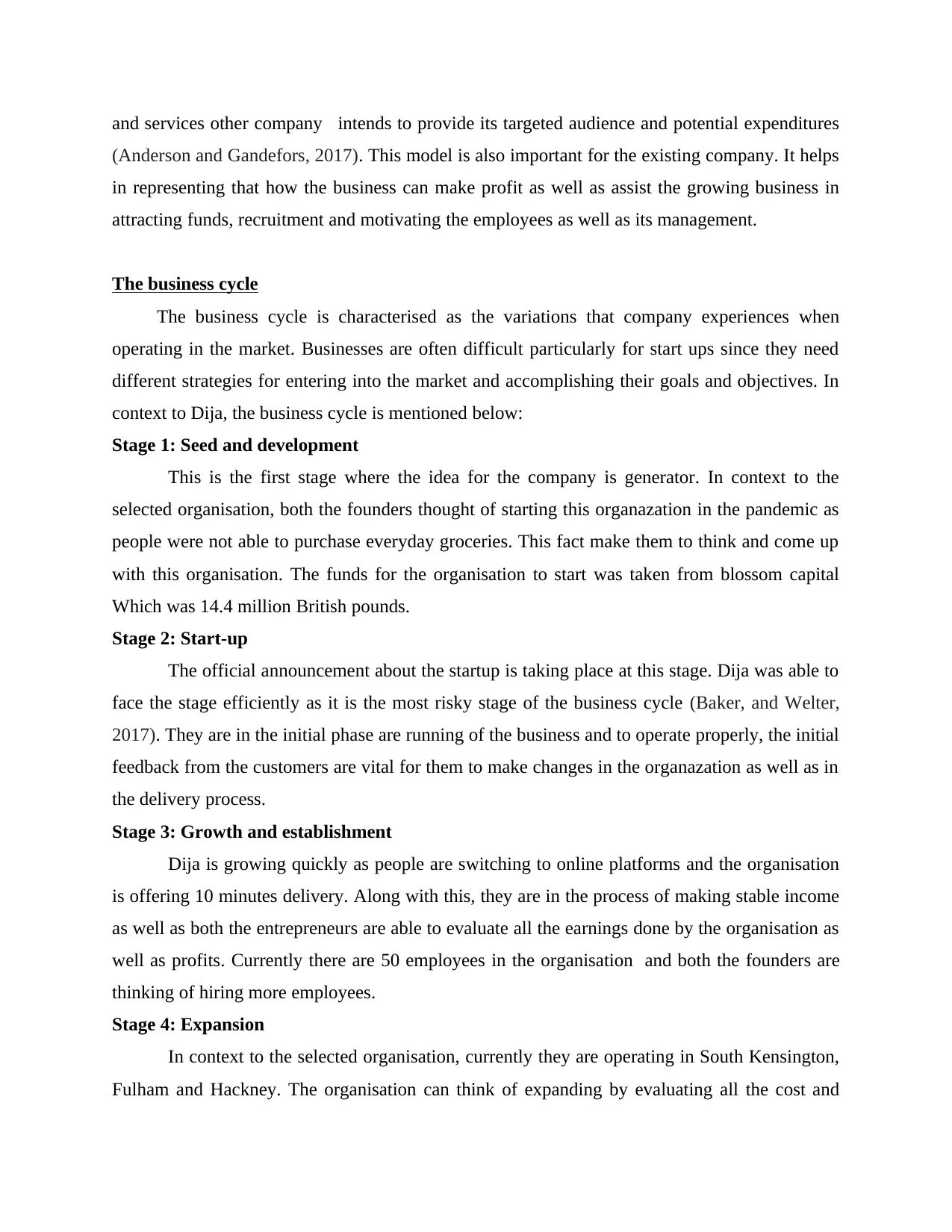
and services other company intends to provide its targeted audience and potential expenditures
(Anderson and Gandefors, 2017). This model is also important for the existing company. It helps
in representing that how the business can make profit as well as assist the growing business in
attracting funds, recruitment and motivating the employees as well as its management.
The business cycle
The business cycle is characterised as the variations that company experiences when
operating in the market. Businesses are often difficult particularly for start ups since they need
different strategies for entering into the market and accomplishing their goals and objectives. In
context to Dija, the business cycle is mentioned below:
Stage 1: Seed and development
This is the first stage where the idea for the company is generator. In context to the
selected organisation, both the founders thought of starting this organazation in the pandemic as
people were not able to purchase everyday groceries. This fact make them to think and come up
with this organisation. The funds for the organisation to start was taken from blossom capital
Which was 14.4 million British pounds.
Stage 2: Start-up
The official announcement about the startup is taking place at this stage. Dija was able to
face the stage efficiently as it is the most risky stage of the business cycle (Baker, and Welter,
2017). They are in the initial phase are running of the business and to operate properly, the initial
feedback from the customers are vital for them to make changes in the organazation as well as in
the delivery process.
Stage 3: Growth and establishment
Dija is growing quickly as people are switching to online platforms and the organisation
is offering 10 minutes delivery. Along with this, they are in the process of making stable income
as well as both the entrepreneurs are able to evaluate all the earnings done by the organisation as
well as profits. Currently there are 50 employees in the organisation and both the founders are
thinking of hiring more employees.
Stage 4: Expansion
In context to the selected organisation, currently they are operating in South Kensington,
Fulham and Hackney. The organisation can think of expanding by evaluating all the cost and
(Anderson and Gandefors, 2017). This model is also important for the existing company. It helps
in representing that how the business can make profit as well as assist the growing business in
attracting funds, recruitment and motivating the employees as well as its management.
The business cycle
The business cycle is characterised as the variations that company experiences when
operating in the market. Businesses are often difficult particularly for start ups since they need
different strategies for entering into the market and accomplishing their goals and objectives. In
context to Dija, the business cycle is mentioned below:
Stage 1: Seed and development
This is the first stage where the idea for the company is generator. In context to the
selected organisation, both the founders thought of starting this organazation in the pandemic as
people were not able to purchase everyday groceries. This fact make them to think and come up
with this organisation. The funds for the organisation to start was taken from blossom capital
Which was 14.4 million British pounds.
Stage 2: Start-up
The official announcement about the startup is taking place at this stage. Dija was able to
face the stage efficiently as it is the most risky stage of the business cycle (Baker, and Welter,
2017). They are in the initial phase are running of the business and to operate properly, the initial
feedback from the customers are vital for them to make changes in the organazation as well as in
the delivery process.
Stage 3: Growth and establishment
Dija is growing quickly as people are switching to online platforms and the organisation
is offering 10 minutes delivery. Along with this, they are in the process of making stable income
as well as both the entrepreneurs are able to evaluate all the earnings done by the organisation as
well as profits. Currently there are 50 employees in the organisation and both the founders are
thinking of hiring more employees.
Stage 4: Expansion
In context to the selected organisation, currently they are operating in South Kensington,
Fulham and Hackney. The organisation can think of expanding by evaluating all the cost and
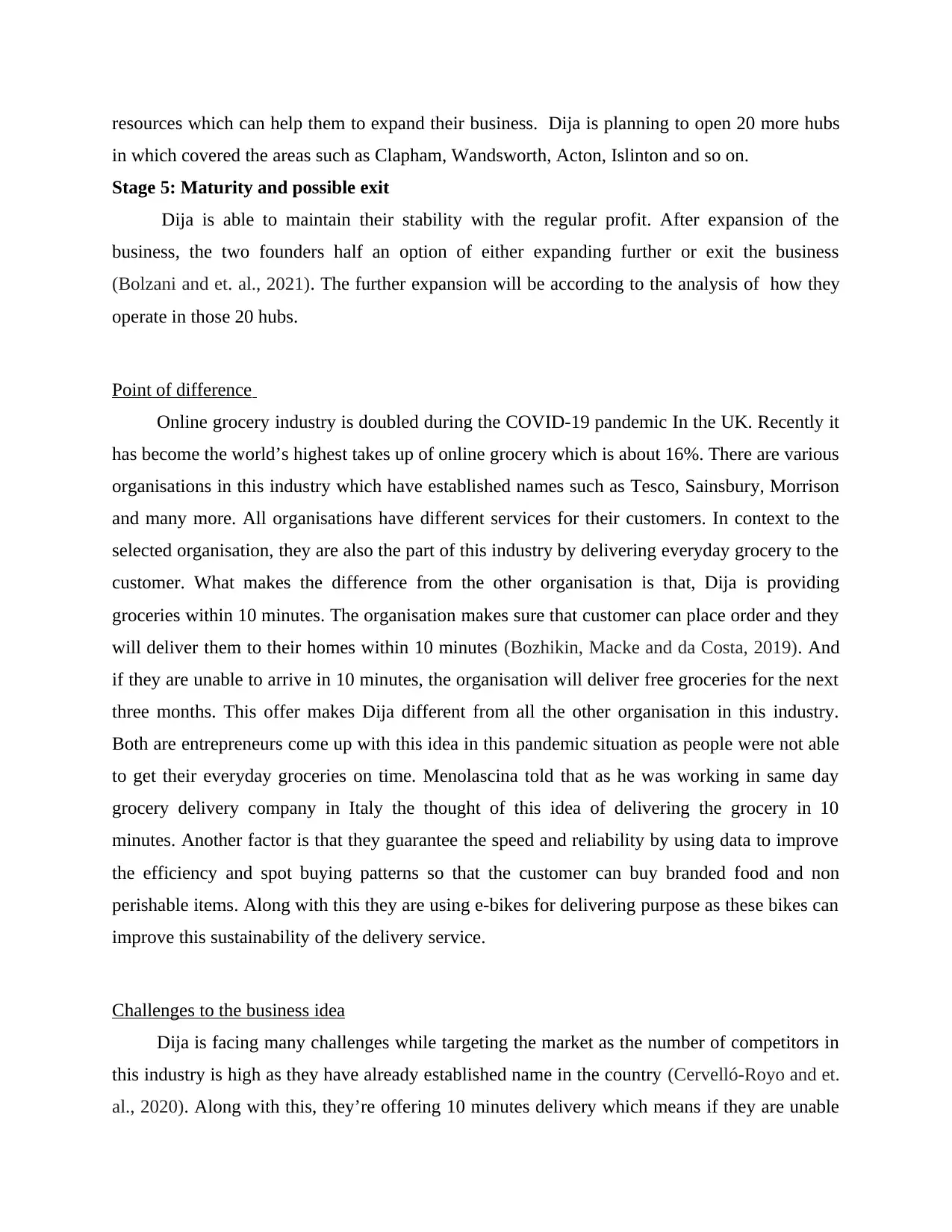
resources which can help them to expand their business. Dija is planning to open 20 more hubs
in which covered the areas such as Clapham, Wandsworth, Acton, Islinton and so on.
Stage 5: Maturity and possible exit
Dija is able to maintain their stability with the regular profit. After expansion of the
business, the two founders half an option of either expanding further or exit the business
(Bolzani and et. al., 2021). The further expansion will be according to the analysis of how they
operate in those 20 hubs.
Point of difference
Online grocery industry is doubled during the COVID-19 pandemic In the UK. Recently it
has become the world’s highest takes up of online grocery which is about 16%. There are various
organisations in this industry which have established names such as Tesco, Sainsbury, Morrison
and many more. All organisations have different services for their customers. In context to the
selected organisation, they are also the part of this industry by delivering everyday grocery to the
customer. What makes the difference from the other organisation is that, Dija is providing
groceries within 10 minutes. The organisation makes sure that customer can place order and they
will deliver them to their homes within 10 minutes (Bozhikin, Macke and da Costa, 2019). And
if they are unable to arrive in 10 minutes, the organisation will deliver free groceries for the next
three months. This offer makes Dija different from all the other organisation in this industry.
Both are entrepreneurs come up with this idea in this pandemic situation as people were not able
to get their everyday groceries on time. Menolascina told that as he was working in same day
grocery delivery company in Italy the thought of this idea of delivering the grocery in 10
minutes. Another factor is that they guarantee the speed and reliability by using data to improve
the efficiency and spot buying patterns so that the customer can buy branded food and non
perishable items. Along with this they are using e-bikes for delivering purpose as these bikes can
improve this sustainability of the delivery service.
Challenges to the business idea
Dija is facing many challenges while targeting the market as the number of competitors in
this industry is high as they have already established name in the country (Cervelló-Royo and et.
al., 2020). Along with this, they’re offering 10 minutes delivery which means if they are unable
in which covered the areas such as Clapham, Wandsworth, Acton, Islinton and so on.
Stage 5: Maturity and possible exit
Dija is able to maintain their stability with the regular profit. After expansion of the
business, the two founders half an option of either expanding further or exit the business
(Bolzani and et. al., 2021). The further expansion will be according to the analysis of how they
operate in those 20 hubs.
Point of difference
Online grocery industry is doubled during the COVID-19 pandemic In the UK. Recently it
has become the world’s highest takes up of online grocery which is about 16%. There are various
organisations in this industry which have established names such as Tesco, Sainsbury, Morrison
and many more. All organisations have different services for their customers. In context to the
selected organisation, they are also the part of this industry by delivering everyday grocery to the
customer. What makes the difference from the other organisation is that, Dija is providing
groceries within 10 minutes. The organisation makes sure that customer can place order and they
will deliver them to their homes within 10 minutes (Bozhikin, Macke and da Costa, 2019). And
if they are unable to arrive in 10 minutes, the organisation will deliver free groceries for the next
three months. This offer makes Dija different from all the other organisation in this industry.
Both are entrepreneurs come up with this idea in this pandemic situation as people were not able
to get their everyday groceries on time. Menolascina told that as he was working in same day
grocery delivery company in Italy the thought of this idea of delivering the grocery in 10
minutes. Another factor is that they guarantee the speed and reliability by using data to improve
the efficiency and spot buying patterns so that the customer can buy branded food and non
perishable items. Along with this they are using e-bikes for delivering purpose as these bikes can
improve this sustainability of the delivery service.
Challenges to the business idea
Dija is facing many challenges while targeting the market as the number of competitors in
this industry is high as they have already established name in the country (Cervelló-Royo and et.
al., 2020). Along with this, they’re offering 10 minutes delivery which means if they are unable
⊘ This is a preview!⊘
Do you want full access?
Subscribe today to unlock all pages.

Trusted by 1+ million students worldwide
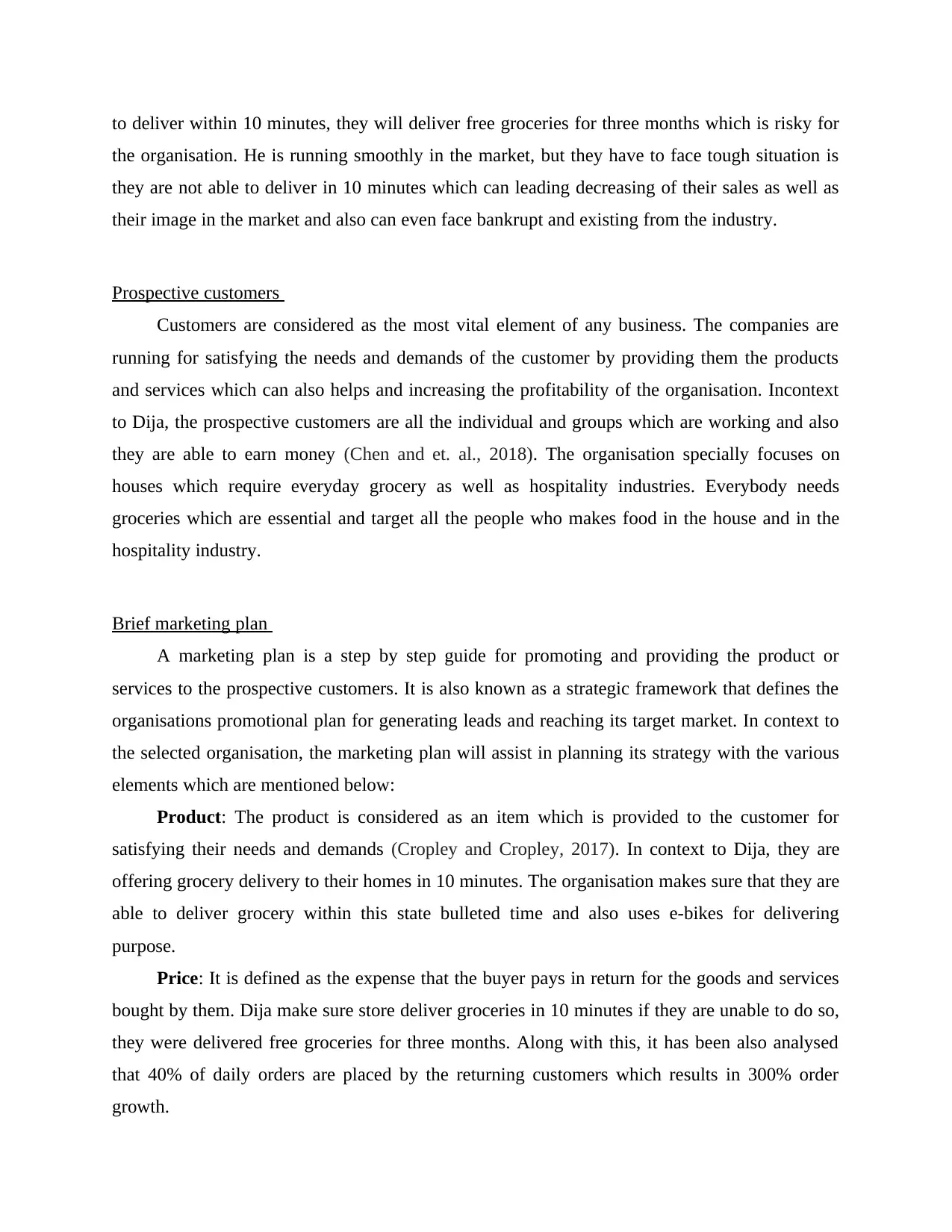
to deliver within 10 minutes, they will deliver free groceries for three months which is risky for
the organisation. He is running smoothly in the market, but they have to face tough situation is
they are not able to deliver in 10 minutes which can leading decreasing of their sales as well as
their image in the market and also can even face bankrupt and existing from the industry.
Prospective customers
Customers are considered as the most vital element of any business. The companies are
running for satisfying the needs and demands of the customer by providing them the products
and services which can also helps and increasing the profitability of the organisation. Incontext
to Dija, the prospective customers are all the individual and groups which are working and also
they are able to earn money (Chen and et. al., 2018). The organisation specially focuses on
houses which require everyday grocery as well as hospitality industries. Everybody needs
groceries which are essential and target all the people who makes food in the house and in the
hospitality industry.
Brief marketing plan
A marketing plan is a step by step guide for promoting and providing the product or
services to the prospective customers. It is also known as a strategic framework that defines the
organisations promotional plan for generating leads and reaching its target market. In context to
the selected organisation, the marketing plan will assist in planning its strategy with the various
elements which are mentioned below:
Product: The product is considered as an item which is provided to the customer for
satisfying their needs and demands (Cropley and Cropley, 2017). In context to Dija, they are
offering grocery delivery to their homes in 10 minutes. The organisation makes sure that they are
able to deliver grocery within this state bulleted time and also uses e-bikes for delivering
purpose.
Price: It is defined as the expense that the buyer pays in return for the goods and services
bought by them. Dija make sure store deliver groceries in 10 minutes if they are unable to do so,
they were delivered free groceries for three months. Along with this, it has been also analysed
that 40% of daily orders are placed by the returning customers which results in 300% order
growth.
the organisation. He is running smoothly in the market, but they have to face tough situation is
they are not able to deliver in 10 minutes which can leading decreasing of their sales as well as
their image in the market and also can even face bankrupt and existing from the industry.
Prospective customers
Customers are considered as the most vital element of any business. The companies are
running for satisfying the needs and demands of the customer by providing them the products
and services which can also helps and increasing the profitability of the organisation. Incontext
to Dija, the prospective customers are all the individual and groups which are working and also
they are able to earn money (Chen and et. al., 2018). The organisation specially focuses on
houses which require everyday grocery as well as hospitality industries. Everybody needs
groceries which are essential and target all the people who makes food in the house and in the
hospitality industry.
Brief marketing plan
A marketing plan is a step by step guide for promoting and providing the product or
services to the prospective customers. It is also known as a strategic framework that defines the
organisations promotional plan for generating leads and reaching its target market. In context to
the selected organisation, the marketing plan will assist in planning its strategy with the various
elements which are mentioned below:
Product: The product is considered as an item which is provided to the customer for
satisfying their needs and demands (Cropley and Cropley, 2017). In context to Dija, they are
offering grocery delivery to their homes in 10 minutes. The organisation makes sure that they are
able to deliver grocery within this state bulleted time and also uses e-bikes for delivering
purpose.
Price: It is defined as the expense that the buyer pays in return for the goods and services
bought by them. Dija make sure store deliver groceries in 10 minutes if they are unable to do so,
they were delivered free groceries for three months. Along with this, it has been also analysed
that 40% of daily orders are placed by the returning customers which results in 300% order
growth.
Paraphrase This Document
Need a fresh take? Get an instant paraphrase of this document with our AI Paraphraser
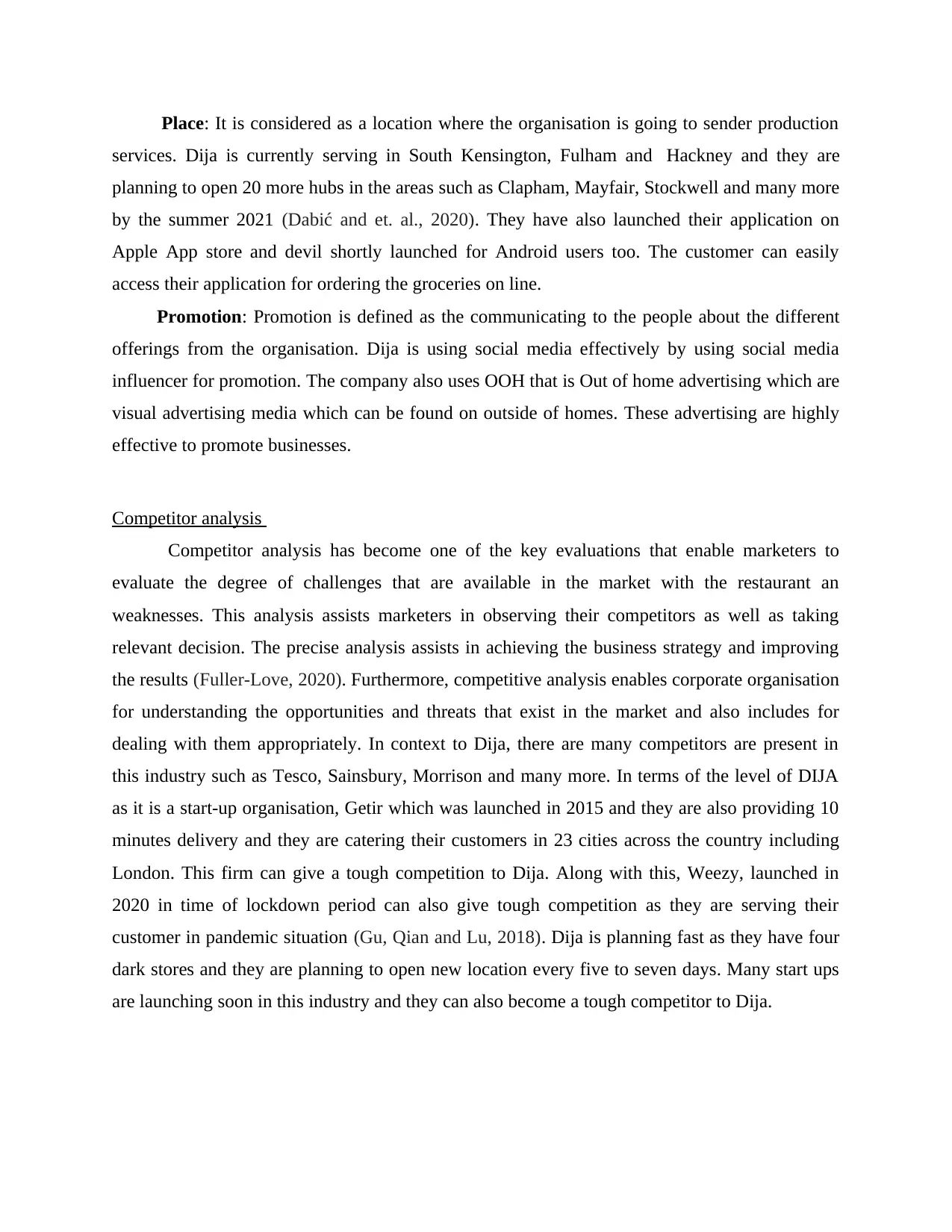
Place: It is considered as a location where the organisation is going to sender production
services. Dija is currently serving in South Kensington, Fulham and Hackney and they are
planning to open 20 more hubs in the areas such as Clapham, Mayfair, Stockwell and many more
by the summer 2021 (Dabić and et. al., 2020). They have also launched their application on
Apple App store and devil shortly launched for Android users too. The customer can easily
access their application for ordering the groceries on line.
Promotion: Promotion is defined as the communicating to the people about the different
offerings from the organisation. Dija is using social media effectively by using social media
influencer for promotion. The company also uses OOH that is Out of home advertising which are
visual advertising media which can be found on outside of homes. These advertising are highly
effective to promote businesses.
Competitor analysis
Competitor analysis has become one of the key evaluations that enable marketers to
evaluate the degree of challenges that are available in the market with the restaurant an
weaknesses. This analysis assists marketers in observing their competitors as well as taking
relevant decision. The precise analysis assists in achieving the business strategy and improving
the results (Fuller-Love, 2020). Furthermore, competitive analysis enables corporate organisation
for understanding the opportunities and threats that exist in the market and also includes for
dealing with them appropriately. In context to Dija, there are many competitors are present in
this industry such as Tesco, Sainsbury, Morrison and many more. In terms of the level of DIJA
as it is a start-up organisation, Getir which was launched in 2015 and they are also providing 10
minutes delivery and they are catering their customers in 23 cities across the country including
London. This firm can give a tough competition to Dija. Along with this, Weezy, launched in
2020 in time of lockdown period can also give tough competition as they are serving their
customer in pandemic situation (Gu, Qian and Lu, 2018). Dija is planning fast as they have four
dark stores and they are planning to open new location every five to seven days. Many start ups
are launching soon in this industry and they can also become a tough competitor to Dija.
services. Dija is currently serving in South Kensington, Fulham and Hackney and they are
planning to open 20 more hubs in the areas such as Clapham, Mayfair, Stockwell and many more
by the summer 2021 (Dabić and et. al., 2020). They have also launched their application on
Apple App store and devil shortly launched for Android users too. The customer can easily
access their application for ordering the groceries on line.
Promotion: Promotion is defined as the communicating to the people about the different
offerings from the organisation. Dija is using social media effectively by using social media
influencer for promotion. The company also uses OOH that is Out of home advertising which are
visual advertising media which can be found on outside of homes. These advertising are highly
effective to promote businesses.
Competitor analysis
Competitor analysis has become one of the key evaluations that enable marketers to
evaluate the degree of challenges that are available in the market with the restaurant an
weaknesses. This analysis assists marketers in observing their competitors as well as taking
relevant decision. The precise analysis assists in achieving the business strategy and improving
the results (Fuller-Love, 2020). Furthermore, competitive analysis enables corporate organisation
for understanding the opportunities and threats that exist in the market and also includes for
dealing with them appropriately. In context to Dija, there are many competitors are present in
this industry such as Tesco, Sainsbury, Morrison and many more. In terms of the level of DIJA
as it is a start-up organisation, Getir which was launched in 2015 and they are also providing 10
minutes delivery and they are catering their customers in 23 cities across the country including
London. This firm can give a tough competition to Dija. Along with this, Weezy, launched in
2020 in time of lockdown period can also give tough competition as they are serving their
customer in pandemic situation (Gu, Qian and Lu, 2018). Dija is planning fast as they have four
dark stores and they are planning to open new location every five to seven days. Many start ups
are launching soon in this industry and they can also become a tough competitor to Dija.
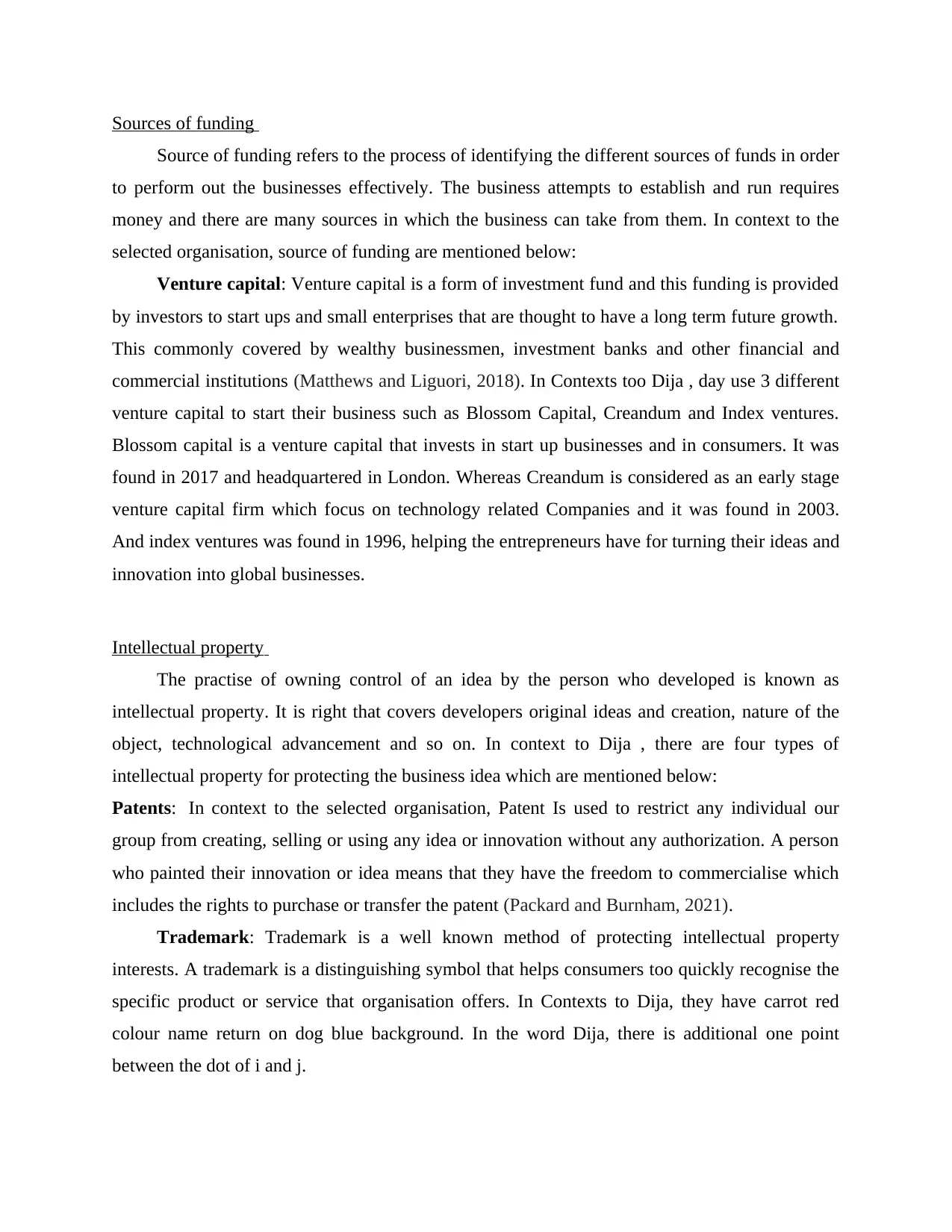
Sources of funding
Source of funding refers to the process of identifying the different sources of funds in order
to perform out the businesses effectively. The business attempts to establish and run requires
money and there are many sources in which the business can take from them. In context to the
selected organisation, source of funding are mentioned below:
Venture capital: Venture capital is a form of investment fund and this funding is provided
by investors to start ups and small enterprises that are thought to have a long term future growth.
This commonly covered by wealthy businessmen, investment banks and other financial and
commercial institutions (Matthews and Liguori, 2018). In Contexts too Dija , day use 3 different
venture capital to start their business such as Blossom Capital, Creandum and Index ventures.
Blossom capital is a venture capital that invests in start up businesses and in consumers. It was
found in 2017 and headquartered in London. Whereas Creandum is considered as an early stage
venture capital firm which focus on technology related Companies and it was found in 2003.
And index ventures was found in 1996, helping the entrepreneurs have for turning their ideas and
innovation into global businesses.
Intellectual property
The practise of owning control of an idea by the person who developed is known as
intellectual property. It is right that covers developers original ideas and creation, nature of the
object, technological advancement and so on. In context to Dija , there are four types of
intellectual property for protecting the business idea which are mentioned below:
Patents: In context to the selected organisation, Patent Is used to restrict any individual our
group from creating, selling or using any idea or innovation without any authorization. A person
who painted their innovation or idea means that they have the freedom to commercialise which
includes the rights to purchase or transfer the patent (Packard and Burnham, 2021).
Trademark: Trademark is a well known method of protecting intellectual property
interests. A trademark is a distinguishing symbol that helps consumers too quickly recognise the
specific product or service that organisation offers. In Contexts to Dija, they have carrot red
colour name return on dog blue background. In the word Dija, there is additional one point
between the dot of i and j.
Source of funding refers to the process of identifying the different sources of funds in order
to perform out the businesses effectively. The business attempts to establish and run requires
money and there are many sources in which the business can take from them. In context to the
selected organisation, source of funding are mentioned below:
Venture capital: Venture capital is a form of investment fund and this funding is provided
by investors to start ups and small enterprises that are thought to have a long term future growth.
This commonly covered by wealthy businessmen, investment banks and other financial and
commercial institutions (Matthews and Liguori, 2018). In Contexts too Dija , day use 3 different
venture capital to start their business such as Blossom Capital, Creandum and Index ventures.
Blossom capital is a venture capital that invests in start up businesses and in consumers. It was
found in 2017 and headquartered in London. Whereas Creandum is considered as an early stage
venture capital firm which focus on technology related Companies and it was found in 2003.
And index ventures was found in 1996, helping the entrepreneurs have for turning their ideas and
innovation into global businesses.
Intellectual property
The practise of owning control of an idea by the person who developed is known as
intellectual property. It is right that covers developers original ideas and creation, nature of the
object, technological advancement and so on. In context to Dija , there are four types of
intellectual property for protecting the business idea which are mentioned below:
Patents: In context to the selected organisation, Patent Is used to restrict any individual our
group from creating, selling or using any idea or innovation without any authorization. A person
who painted their innovation or idea means that they have the freedom to commercialise which
includes the rights to purchase or transfer the patent (Packard and Burnham, 2021).
Trademark: Trademark is a well known method of protecting intellectual property
interests. A trademark is a distinguishing symbol that helps consumers too quickly recognise the
specific product or service that organisation offers. In Contexts to Dija, they have carrot red
colour name return on dog blue background. In the word Dija, there is additional one point
between the dot of i and j.
⊘ This is a preview!⊘
Do you want full access?
Subscribe today to unlock all pages.

Trusted by 1+ million students worldwide
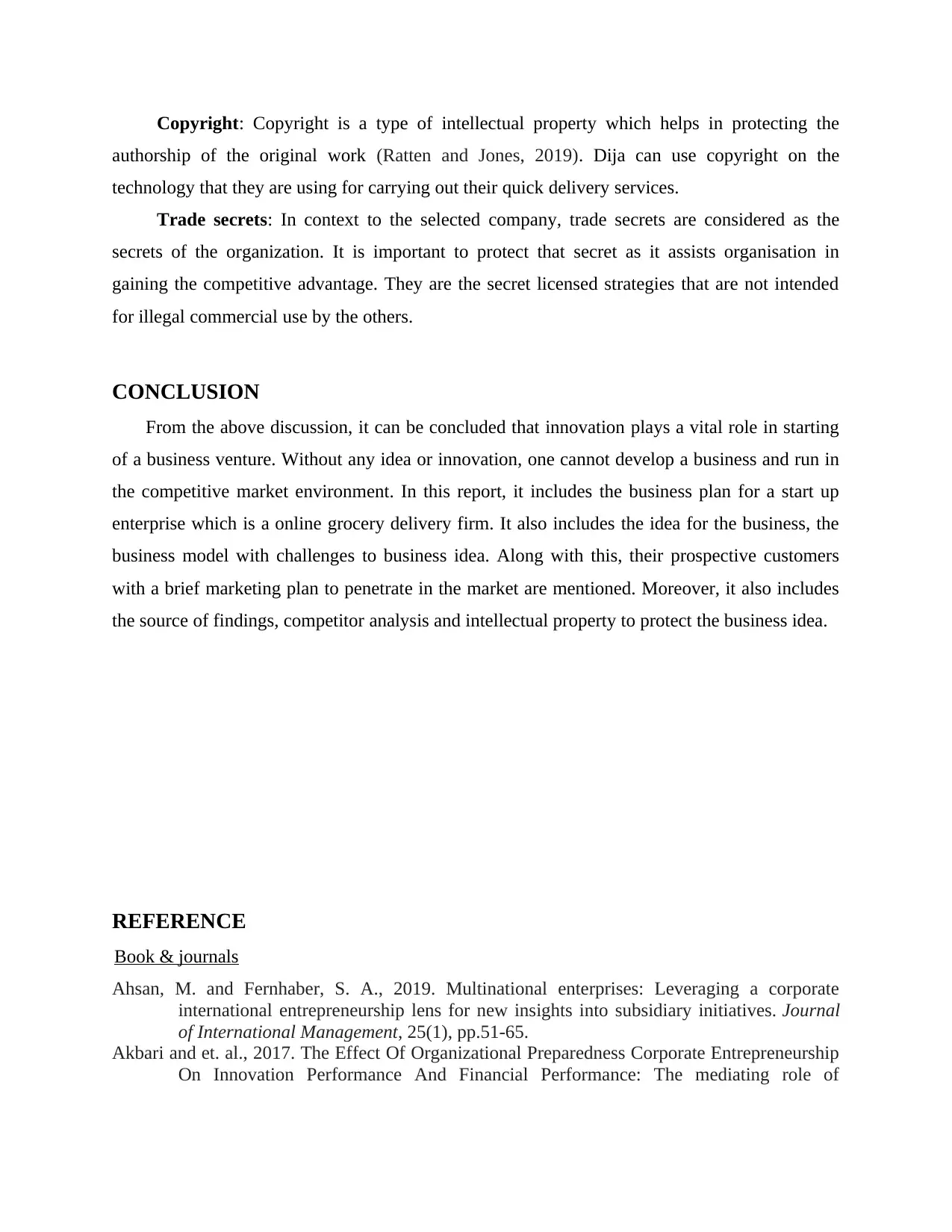
Copyright: Copyright is a type of intellectual property which helps in protecting the
authorship of the original work (Ratten and Jones, 2019). Dija can use copyright on the
technology that they are using for carrying out their quick delivery services.
Trade secrets: In context to the selected company, trade secrets are considered as the
secrets of the organization. It is important to protect that secret as it assists organisation in
gaining the competitive advantage. They are the secret licensed strategies that are not intended
for illegal commercial use by the others.
CONCLUSION
From the above discussion, it can be concluded that innovation plays a vital role in starting
of a business venture. Without any idea or innovation, one cannot develop a business and run in
the competitive market environment. In this report, it includes the business plan for a start up
enterprise which is a online grocery delivery firm. It also includes the idea for the business, the
business model with challenges to business idea. Along with this, their prospective customers
with a brief marketing plan to penetrate in the market are mentioned. Moreover, it also includes
the source of findings, competitor analysis and intellectual property to protect the business idea.
REFERENCE
Book & journals
Ahsan, M. and Fernhaber, S. A., 2019. Multinational enterprises: Leveraging a corporate
international entrepreneurship lens for new insights into subsidiary initiatives. Journal
of International Management, 25(1), pp.51-65.
Akbari and et. al., 2017. The Effect Of Organizational Preparedness Corporate Entrepreneurship
On Innovation Performance And Financial Performance: The mediating role of
authorship of the original work (Ratten and Jones, 2019). Dija can use copyright on the
technology that they are using for carrying out their quick delivery services.
Trade secrets: In context to the selected company, trade secrets are considered as the
secrets of the organization. It is important to protect that secret as it assists organisation in
gaining the competitive advantage. They are the secret licensed strategies that are not intended
for illegal commercial use by the others.
CONCLUSION
From the above discussion, it can be concluded that innovation plays a vital role in starting
of a business venture. Without any idea or innovation, one cannot develop a business and run in
the competitive market environment. In this report, it includes the business plan for a start up
enterprise which is a online grocery delivery firm. It also includes the idea for the business, the
business model with challenges to business idea. Along with this, their prospective customers
with a brief marketing plan to penetrate in the market are mentioned. Moreover, it also includes
the source of findings, competitor analysis and intellectual property to protect the business idea.
REFERENCE
Book & journals
Ahsan, M. and Fernhaber, S. A., 2019. Multinational enterprises: Leveraging a corporate
international entrepreneurship lens for new insights into subsidiary initiatives. Journal
of International Management, 25(1), pp.51-65.
Akbari and et. al., 2017. The Effect Of Organizational Preparedness Corporate Entrepreneurship
On Innovation Performance And Financial Performance: The mediating role of
Paraphrase This Document
Need a fresh take? Get an instant paraphrase of this document with our AI Paraphraser
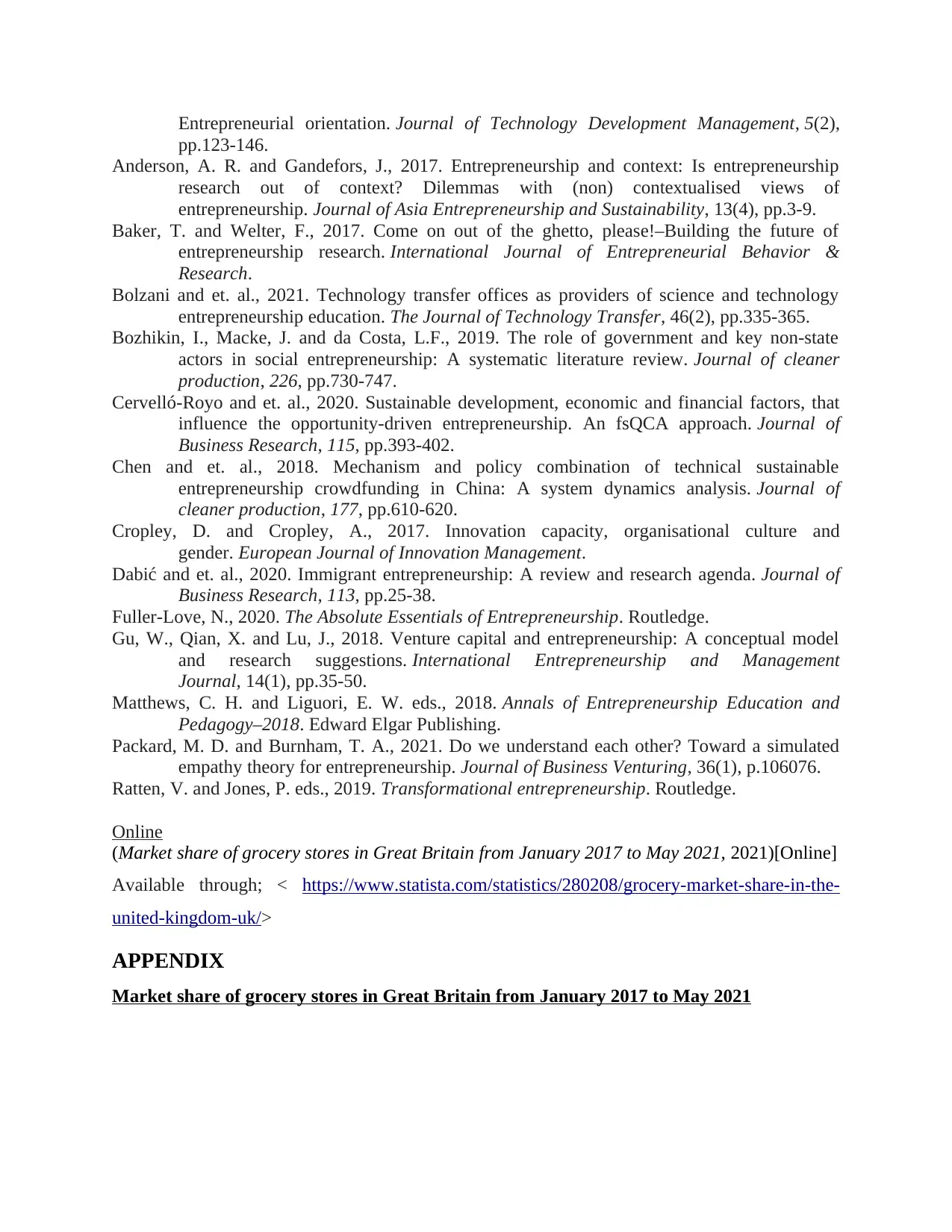
Entrepreneurial orientation. Journal of Technology Development Management, 5(2),
pp.123-146.
Anderson, A. R. and Gandefors, J., 2017. Entrepreneurship and context: Is entrepreneurship
research out of context? Dilemmas with (non) contextualised views of
entrepreneurship. Journal of Asia Entrepreneurship and Sustainability, 13(4), pp.3-9.
Baker, T. and Welter, F., 2017. Come on out of the ghetto, please!–Building the future of
entrepreneurship research. International Journal of Entrepreneurial Behavior &
Research.
Bolzani and et. al., 2021. Technology transfer offices as providers of science and technology
entrepreneurship education. The Journal of Technology Transfer, 46(2), pp.335-365.
Bozhikin, I., Macke, J. and da Costa, L.F., 2019. The role of government and key non-state
actors in social entrepreneurship: A systematic literature review. Journal of cleaner
production, 226, pp.730-747.
Cervelló-Royo and et. al., 2020. Sustainable development, economic and financial factors, that
influence the opportunity-driven entrepreneurship. An fsQCA approach. Journal of
Business Research, 115, pp.393-402.
Chen and et. al., 2018. Mechanism and policy combination of technical sustainable
entrepreneurship crowdfunding in China: A system dynamics analysis. Journal of
cleaner production, 177, pp.610-620.
Cropley, D. and Cropley, A., 2017. Innovation capacity, organisational culture and
gender. European Journal of Innovation Management.
Dabić and et. al., 2020. Immigrant entrepreneurship: A review and research agenda. Journal of
Business Research, 113, pp.25-38.
Fuller-Love, N., 2020. The Absolute Essentials of Entrepreneurship. Routledge.
Gu, W., Qian, X. and Lu, J., 2018. Venture capital and entrepreneurship: A conceptual model
and research suggestions. International Entrepreneurship and Management
Journal, 14(1), pp.35-50.
Matthews, C. H. and Liguori, E. W. eds., 2018. Annals of Entrepreneurship Education and
Pedagogy–2018. Edward Elgar Publishing.
Packard, M. D. and Burnham, T. A., 2021. Do we understand each other? Toward a simulated
empathy theory for entrepreneurship. Journal of Business Venturing, 36(1), p.106076.
Ratten, V. and Jones, P. eds., 2019. Transformational entrepreneurship. Routledge.
Online
(Market share of grocery stores in Great Britain from January 2017 to May 2021, 2021)[Online]
Available through; < https://www.statista.com/statistics/280208/grocery-market-share-in-the-
united-kingdom-uk/>
APPENDIX
Market share of grocery stores in Great Britain from January 2017 to May 2021
pp.123-146.
Anderson, A. R. and Gandefors, J., 2017. Entrepreneurship and context: Is entrepreneurship
research out of context? Dilemmas with (non) contextualised views of
entrepreneurship. Journal of Asia Entrepreneurship and Sustainability, 13(4), pp.3-9.
Baker, T. and Welter, F., 2017. Come on out of the ghetto, please!–Building the future of
entrepreneurship research. International Journal of Entrepreneurial Behavior &
Research.
Bolzani and et. al., 2021. Technology transfer offices as providers of science and technology
entrepreneurship education. The Journal of Technology Transfer, 46(2), pp.335-365.
Bozhikin, I., Macke, J. and da Costa, L.F., 2019. The role of government and key non-state
actors in social entrepreneurship: A systematic literature review. Journal of cleaner
production, 226, pp.730-747.
Cervelló-Royo and et. al., 2020. Sustainable development, economic and financial factors, that
influence the opportunity-driven entrepreneurship. An fsQCA approach. Journal of
Business Research, 115, pp.393-402.
Chen and et. al., 2018. Mechanism and policy combination of technical sustainable
entrepreneurship crowdfunding in China: A system dynamics analysis. Journal of
cleaner production, 177, pp.610-620.
Cropley, D. and Cropley, A., 2017. Innovation capacity, organisational culture and
gender. European Journal of Innovation Management.
Dabić and et. al., 2020. Immigrant entrepreneurship: A review and research agenda. Journal of
Business Research, 113, pp.25-38.
Fuller-Love, N., 2020. The Absolute Essentials of Entrepreneurship. Routledge.
Gu, W., Qian, X. and Lu, J., 2018. Venture capital and entrepreneurship: A conceptual model
and research suggestions. International Entrepreneurship and Management
Journal, 14(1), pp.35-50.
Matthews, C. H. and Liguori, E. W. eds., 2018. Annals of Entrepreneurship Education and
Pedagogy–2018. Edward Elgar Publishing.
Packard, M. D. and Burnham, T. A., 2021. Do we understand each other? Toward a simulated
empathy theory for entrepreneurship. Journal of Business Venturing, 36(1), p.106076.
Ratten, V. and Jones, P. eds., 2019. Transformational entrepreneurship. Routledge.
Online
(Market share of grocery stores in Great Britain from January 2017 to May 2021, 2021)[Online]
Available through; < https://www.statista.com/statistics/280208/grocery-market-share-in-the-
united-kingdom-uk/>
APPENDIX
Market share of grocery stores in Great Britain from January 2017 to May 2021
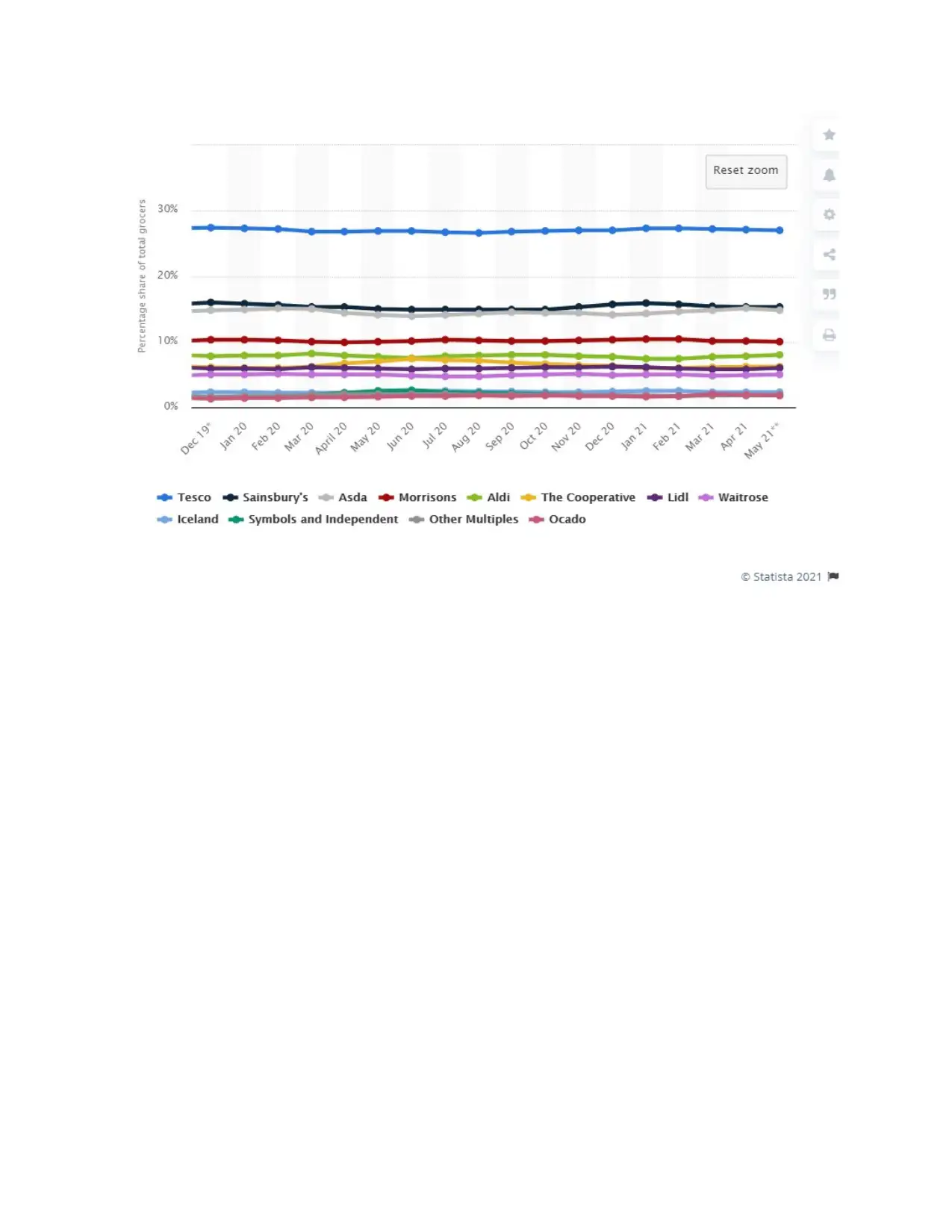
⊘ This is a preview!⊘
Do you want full access?
Subscribe today to unlock all pages.

Trusted by 1+ million students worldwide
1 out of 12
Related Documents
Your All-in-One AI-Powered Toolkit for Academic Success.
+13062052269
info@desklib.com
Available 24*7 on WhatsApp / Email
![[object Object]](/_next/static/media/star-bottom.7253800d.svg)
Unlock your academic potential
Copyright © 2020–2025 A2Z Services. All Rights Reserved. Developed and managed by ZUCOL.





